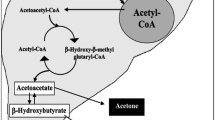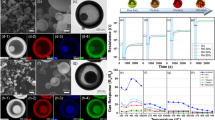Abstract
Over 90 % of diabetic patients have Type 2 diabetes. Although an elevated mean breath acetone concentration has been found to exist in Type 1 diabetes (T1D), information on breath acetone in Type 2 diabetes (T2D) has yet to be obtained. In this study, we first used gas chromatography–mass spectrometry (GC–MS) to validate a ringdown breath-acetone analyzer based on the cavity-ringdown-spectroscopy technique, through comparing breath acetone concentrations in the range 0.5–2.5 ppm measured using both methods. The linear fitting of R = 0.99 suggests that the acetone concentrations obtained using both methods are consistent with a largest standard deviation of ±0.4 ppm in the lowest concentration of the range. Next, 620 breath samples from 149 T2D patients and 42 healthy subjects were collected and tested using the breath analyzer. Four breath samples were taken from each subject under each of four different conditions: fasting, 2 h post-breakfast, 2 h post-lunch, and 2 h post-dinner. Simultaneous blood glucose levels were also measured using a standard diabetic-management blood-glucose meter. For the 149 T2D subjects, their exhaled breath acetone concentrations ranged from 0.1 to 19.8 ppm; four different ranges of breath acetone concentration, 0.1–19.8, 0.1–7.1, 0.1–6.3, and 0.1–9.5 ppm, were obtained for the subjects under the four different conditions, respectively. For the 42 healthy subjects, their breath acetone concentration ranged from 0.1 to 2.6 ppm; four different ranges of breath acetone concentration, 0.3–2.6, 0.1–2.6, 0.1–1.7, and 0.3–1.6 ppm, were obtained for the four different conditions. The mean breath acetone concentration of the 149 T2D subjects was determined to be 1.5 ± 1.5 ppm, which was 1.5 times that of 1.0 ± 0.6 ppm for the 42 healthy subjects. No correlation was found between the breath acetone concentration and the blood glucose level of the T2D subjects and the healthy volunteers. This study using a relatively large number of subjects provides new data regarding breath acetone in diabetes (T1D and T2D) and suggests that an elevated mean breath acetone concentration also exists in T2D.







Similar content being viewed by others
References
Mürtz M (2005) Breath diagnostics using laser spectroscopy. Opt Photonics News 16:30–35
Mürtz M, Halmer D, Horstjann M, Thelen S, Hering P (2006) Ultra sensitive trace gas detection for biomedical applications. Spectrochim Acta A 63:963–969
Risby TH, Solga SF (2006) Current status of clinical breath analysis. Appl Phys B 85:421–426
Mccurdy MR, Bakhirkin Y, Wysocki G, Lewicki R, Tittel FK (2007) Recent advances of laser-spectroscopy-based techniques for applications in breath analysis. J Breath Res 1:014001
Natale CD, Paolesse R, Martinelli E, Capuano R (2014) Solid-state gas sensors for breath analysis: a review. Anal Chim Acta 824:1–17
Deng C, Zhang J, Yu X, Zhang W, Zhang X (2004) Determination of acetone in human breath by gas chromatography-mass spectrometry and solid-phase microextraction with on-fiber derivatization. J Chromatogr B 810:269–275
Anderson JC, Lamm WJ, Hlastala MP (2006) Measuring airway exchange of endogenous acetone using a single-exhalation breathing maneuver. J Appl Physiol 100:880–889
Diskin AM, Španěl P, Smith D (2003) Time variation of ammonia, acetone, isoprene and ethanol in breath: a quantitative SIFT-MS study over 30 days. Physiol Meas 24:107–109
Turner C, Španěl P, Smith D (2006) A longitudinal study of ammonia, acetone and propanol in the exhaled breath of 30 subjects using selected ion flow tube mass spectrometry, SIFT-MS. Physiol Meas 27:321–337
Smith D, Španěl P (2005) Selected ion flow tube mass spectrometry (SIFT-MS) for on-line trace gas analysis. Mass Spectrom Rev 24:661–700
Teshima N, Li J, Toda K, Dasgupta PK (2005) Determination of acetone in breath. Anal Chim Acta 535:189–229
Smith D, Španěl P, Davies S (1999) Trace gases in breath of healthy volunteers when fasting and after a protein-calorie meal: a preliminary study. J Appl Physiol 87:1584–1588
Smith D, Španěl P, Fryer A, Hanna F et al (2011) Can volatile compounds in exhaled breath be used to monitor control in diabetes mellitus? J Breath Res 5:022001
Nelson N, Lagesson V, Nosratabadi A, Ludvigsson J, Tagesson C (1998) Exhaled isoprene and acetone in newborn infants and in children with diabetes mellitus. Pediatr Res 44:363–367
Rooth G, Ostenson S (1966) Acetone in alveolar air, and the control of diabetes. Lancet 288:1102–1105
Tasspopoulos C, Barnett D, Fraser T (1969) Breath-acetone and blood-sugar measurements in diabetes. Lancet 293:1282–1286
Henderson M, Karger B, Wrenshall G (1952) Acetoe in the breath: a study of acetone exhalation in diabetic and nondiabeic human subjects. Diabetes 1:188–193
Turner C, Walton C, Hoashi S, Evans M (2009) Breath acetone concentration decrease with blood glucose concentration in type 1 diabetes mellitus patients during hypoglycaemic clamps. J Breath Res 3:046004
Wang C, Mbi A, Shepherd M (2010) A study on breath acetone in diabetic patients using a cavity ringdown breath analyzer: exploring correlations of breath acetone with blood glucose and glycohemoglobin A1C. IEEE Sens J 10:54–63
Wang Z, Wang C (2013) Is breath acetone a biomarker of diabetes—a historical review on breath acetone measurements. J Breath Res 7:037109
Ueta I, Saito Y, Hosoe M, Okamoto M, Ohkita H, Shirai S, Tamura H, Jinno K (2009) Breath acetone analysis with miniaturized sample preparation device: in-needle preconcentration and subsequent determination by gas chromatography-mass spectroscopy. J Chromatogr B 877:2551–2556
Ulanowska A, Trawinska E, Sawrycki P, Buszewski B (2012) Chemotherapy control by breath profile with application of SPME-GC/MS method. J Sep Sci 35:2908–2913
Montuschi P, Martello S, Felli M, Mondino C, Barnes PJ, Chiarotti M (2005) Liquid chromatography/mass spectrometry analysis of exhaled leukotriene B4 in asthmatic children. Resp Res 6:119
Nording ML, Yang J, Hegedus CM, Bhushan A, Kenyon NJ, Davis CE, Hammock BD (2010) Endogenous levels of five fatty acid metabolites in exhaled breath condensate to monitor asthma by high-performance liquid chromatography: electrospray tandem mass spectrometry. IEEE Sens J 10:123–130
Moser B, Bodrogi F, Eibl G, Lechner M, Rieder J, Lirk P (2005) Mass spectrometric profile of exhaled breath-field study by PTR-MS. Respir Physiol Neurobiol 145:295–300
Harrison GR, Critchley AD, Mayhew CA, Thompson JM (2003) Real-time breath monitoring of propane and its volatile metabolites during surgery using a novel mass spectrometric technique: a feasibility study. Br J Anaesth 91:797–799
Yuan H, Mester Z, Lord H, Pawliszyn J (2000) Automated in-tube solid phase microextraction coupled with liquid chromatography-electrospray ionization mass spectrometry for the determination of selected benzodiazepines. J Anal Toxicol 24:718–725
Ruzsanyi V, Baumbach J, Litterst P, Westhoff M, Freitag L (2005) Detection of human metabolites using multi-capillary columns coupled to ion mobility spectrometers. J Chromatogr A 1084:145–151
Smith D, Wang T, Španěl P (2002) On-line, simultaneous quantification of ethanol, some metabolites and water vapour in breath following the ingestion of alcohol. Physiol Meas 23:477–479
O’keefe A, Deacon DA (1988) Cavity ring-down optical spectrometer for absorption measurements using pulsed laser sources. Rev Sci Instrum 59:2544–2551
Berden G, Peeters R, Meijer G (2000) Cavity ring-down spectroscopy: experimental schemes and applications. Int Rev Phys Chem 22:565–607
Paldus BA, Kachanov AA (2005) An historical overview of cavity-enhanced methods. Can J Phys 83:975–999
Mazurenka M, Orr-Ewing AJ, Peverall R, Ritchie GAD (2005) Cavity ring-down and cavity enhanced spectroscopy using diode lasers. Annu Rep Prog Chem, Sect C: Phys Chem 101:100–142
Wang C. Biomedical applications of cavity ringdown spectroscopy: present and perspective, 57th Southeast/61st Southwest Joint Regional Meeting of the American Chemical Society, November 1–4, 2005, Memphis, TN, USA
Berden G, Engeln R (2009) Cavity ring-down spectroscopy: techniques and applications. Wiley-Blackwell, Chichester
Wang C, Srivastava N, Jones BA, Reese RB (2008) A novel multiple species ringdown spectrometer for in situ measurements of methane, carbon dioxide, and carbon isotope. Appl Phys B 92:259–270
Ciaffoni L, Hancock G, Harrison JJ, van Helden J-PH, Langley CE, Peverall R, Ritchie GAD, Wood S (2013) Demonstration of a mid-infrared cavity enhanced absorption spectrometer for breath acetone detection. Anal Chem 85:846–850
Wang C, Surampudi AB (2008) An acetone breath analyzer using cavity ringdown spectroscopy: an initial test with human subjects under various situations. Meas Sci Technol 22:105604
Wang C, Scherrer ST, Hossain D (2004) Measurements of cavity ringdown spectroscopy of acetone in the ultraviolet and near-infrared spectral regions: potential for development of a breath analyzer. Appl Spectrosc 58:784–791
Wang C, Mbi A (2007) A new acetone detection device using cavity ringdown spectroscopy at 266 nm: evaluation of the instrument performance using acetone sample solutions. Meas Sci Technol 18:2731–2741
Wang Z, Wang C, Lathan P (2013) Breath acetone analysis of diabetic dogs using a cavity ringdown breath analyzer. IEEE Sens J 14:1117–1123
Gong Z, Sun M, Jiang C, Wang Z, Kang M, Li Y, Wang C (2014) A ringdown breath acetone analyzer: performance and validation using gas chromatography-mass spectrometry. J Anal Bioanal Tech S7(2014):013
Hancock G, Langley C, Peverall R, Ritchie G, Taylor D (2014) Laser-based method and sample handling protocol for measuring breath acetone. Anal Chem 86:5838–5843
Miekisch W, Kischkel S, Sawacki A, Liebau T, Mieth M, Schubert J (2008) Impact of sampling procedures on the results of breath analysis. J Breath Res 2:026007
Breathmeter; Available online: http://www.ekipstech.com/pages/homepage/breathmeter/webpagecategory.xml
Schubert J, Miekisch W, Birken T, Geiger K et al (2005) Impact of inspired substance concentrations on the results of breath analysis in mechanically ventilated patients. Biomarkers 10:138–152
Schwoebel H, Schubert R, Sklorz M, Kischkel S, Zimmermann R, Schubert JK, Miekisch W (2011) Phase-resolved real-time breath analysis during exercise by means of smart processing of PTR-MS data. Anal Bioanal Chem 401:2079–2091
Guo D, Zhang D, Zhang L, Lu G (2012) Non-invasive blood glucose monitoring for diabetics by means of breath signal analysis. Sensors Actuators B 173:106–113
Schwarz K et al (2009) Breath acetone-aspects of normal physiology related to age and gender as determined in a PTR-MS study. J Breath Res 3:027003
Španěl P, Dryahina K, Smith D (2007) Acetone, ammonia and hydrogen cyanide in exhaled breath of several volunteers aged 4–83 years. J Breath Res 1:011001
Španěl P, Dryahina K, Smith D (2007) The concentration distributions of some metabolites in the exhaled breath of young adults. J Breath Res 1:026001
Acknowledgments
This work was supported by National Science Foundation of China (grant no. 81471701). The authors thank the numerous volunteers who participated by providing breath-gas samples.
Author information
Authors and Affiliations
Corresponding author
Rights and permissions
About this article
Cite this article
Sun, M., Chen, Z., Gong, Z. et al. Determination of breath acetone in 149 Type 2 diabetic patients using a ringdown breath-acetone analyzer. Anal Bioanal Chem 407, 1641–1650 (2015). https://doi.org/10.1007/s00216-014-8401-8
Received:
Revised:
Accepted:
Published:
Issue Date:
DOI: https://doi.org/10.1007/s00216-014-8401-8




